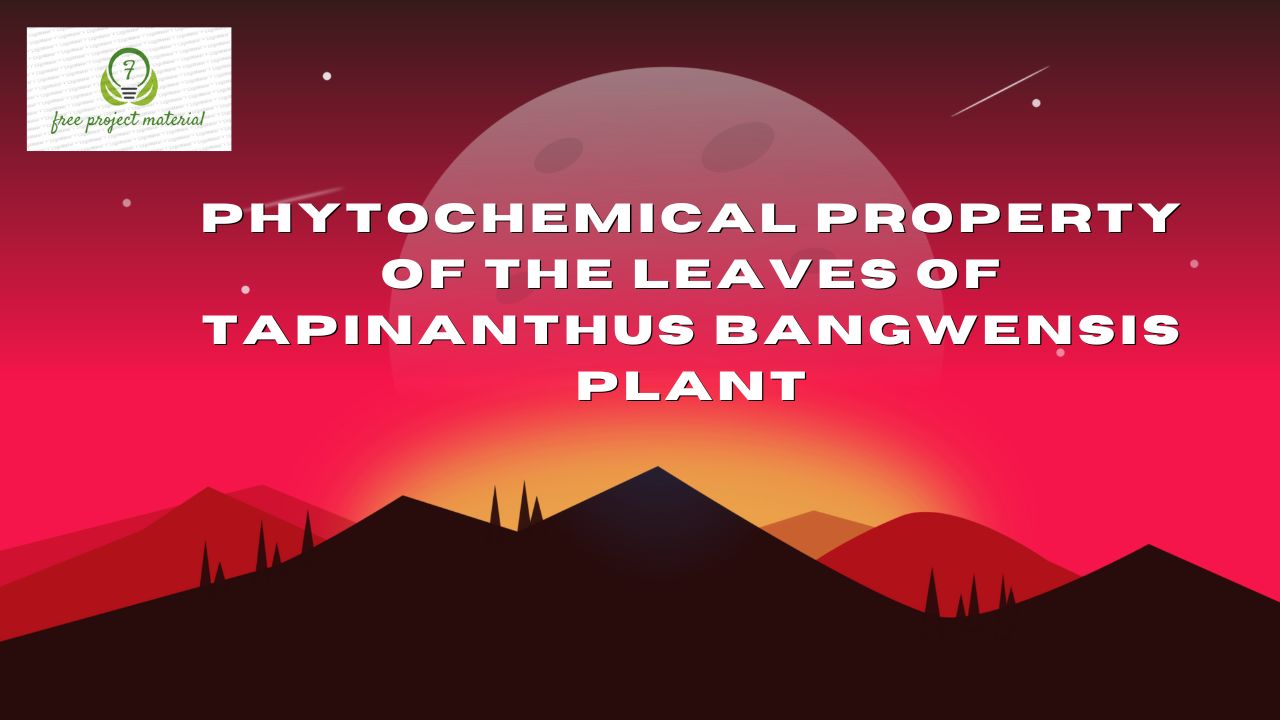ABSTRACT
The quantitative phytochemical analysis of the leaves of Tapinanthus bangwensis plant was carried out using standard analytical procedures. The results revealed the presence of the bioactive components in varying concentrations as follows: Flavonoid (20.025 ± 0.035 mg/100g), tannins (5.153 ± 3.644 mg/100g), alkaloids (4.225 ± 0.035 mg/100g), phenols (2.116 ± 0.148 mg/100g). saponins (1.265 ± 0.0212 mg/100g), and terpenoids (0.971 ± 0.57 mg/100g). The presence of these compounds in appreciable quantities is an indication that the leaves of Tapinanthus bangwensis plant could be utilized traditionally for therapeutic use. Hence, its cultivation should be encouraged.
TABLE OF CONTENTS
TITLE PAGE- – – – – – – – i
CERTIFICATION- – – – – – – ii
DEDICATION- – – – – – – – iii
ACKNOWLEDGEMENTS- – – – – – iv
ABSTRACTS – – – – – – – – v
TABLE OF CONTENTS- – – – – – v-vii
CHAPTER ONE: INTRODUCTION
1.1 Background of the Study- – – – – –
1.2 Aim and Objectives of the Study- – – – –
1.3 Scope and Limitations of the Study- – – – –
CHAPTER TWO: LITERATURE REVIEW
2.1 Description of Tapinanthus bangwensis Plant- – –
2.2 Botanical Classification of Tapinanthus bangwensis Plant-
2.3 Phytochemical property of Tapinanthus bangwensis Plant-
2.3.1 Alkaloids- – – – – – – – –
2.3.2 Phenolic Acid- – – – – – – –
2.3.3 Flavonoid- – – – – – – – –
2.3.4 Tannins- – – – – – – – –
2.3.5 Terpenoids- – – – – – – – –
2.3.6 Saponins- – – – – – – – –
2.4 Medicinal Uses of Tapinanthus bangwensis Plant- – –
2.5 Toxicity of Mistletoe- – – – – – –
CHAPTER THREE: MATERIALS AND METHODS
3.1 Materials and Reagents- – – – – – –
3.1.1 Collection of Plant Sample- – – – – –
3.1.2 Preparation of Plant Sample- – – – – –
3.2 Methods- – – – – – – – –
3.2.1 Determination of Alkaloids- – – – – –
3.2.2 Determination of Saponins- – – – – –
3.2.3 Determination of Tannins- – – – – –
3.2.4 Determination of Flavonoid- – – – – –
3.2.5 Determination of Terpenoids- – – – – –
3.2.6 Determination of Phenolic Acid- – – – –
CHAPTER FOUR: RESULTS AND DISCUSSION
4.1 Results- – – – – – – – –
4.2 Discussion- – – – – – – – –
CHAPTER FIVE: CONCLUSION AND RECOMMENDATIONS
5.1 Conclusion- – – – – – – – –
5.2 Recommendations- – – – – – –
References
CHAPTER ONE: INTRODUCTION
1.1 Background of the Study
In recent years, there has been a gradual revival of interest in the use of medicinal plants in developing countries because herbal medicines have been reported to be safe with little or no adverse side effect especially when compared with synthetic drugs. Thus, a search for new drugs with better and cheaper constituents from plant origin is a natural choice. The medicinal value of these plants lies in some chemical substances that produce a definite physiological action on the human body (Edeoga et al., 2005). Plants have played significant roles in maintaining the health and quality of human life for thousands of years. The majority of the earth’s inhabitants in the developing world rely on traditional medicine for their primary health care needs and a major part of this therapy involves the use of plants, plant extracts or their active principles (Craig, 2001).
Herbaceous plants produce and contain a variety of chemical substances that act upon the body. Medicinal plants and herbs are great important to the health of individuals and communities. Despite the existence of herbal medicines over many centuries, only relatively small number of plant species has been studied for their application. However, in the recent past, an increasing research evidence is getting accumulated which clearly indicate the positive role of traditional medicinal plant in the prevention or control of some metabolic disorders like diabetes heart diseases and certain types of cancer (Zhang, 1996). A scientific investigation of traditional herbal remedies for metabolic disorders may provide valuable lead for the development of alternative drug and therapeutic strategies. Mistletoe is the common name for a group of hemi-parasitic plants in the order santalales that grow attached to and within the branches of a tree or shrub. The leaves of mistletoe (Tapinathus bangwensis) have been used traditionally in Nigeia and other parts of Africa as antihypensive and antidiabetic agents. Various researchers have reported the hypotensive, hypoglycemic and hypolipidemic effect of mistletoe (Tapinathus bangwensis) leaves, which lowers the blood pressure, blood glucose and lipid profile. Mistletoe, with the common name (s)-bird’ lime, all heal devil’s fuge, iscardor, etc. is a general term for woody shoot parasites in several plant families especially loranthaceae and viscaceae (Burkill, 1985; Polhill and Wiens, 1998) and most genera of African mistletoes belong to the family Loranthaceae (Polhill and Wiens, 1998).
Seven genera of the Loranthaceae-Helixanthera, Berhautia, Englerina, Globimetula, Agelanthus, Tapinanthus and Phragmanthera with about five dozens or more species are recognized in West Africa (Burkill, 1985) and the group term mistletoe is used for all the species. Besides the host plant is considered as important as the mistletoe, implying that the biology of the loranthaceae species is not clearly understood. This has implications on the medical use of the plant species in the Loranthaceae.
In west Africa, mistletoes are found on many tree crops of economic importance including the Shea butter (Vitellaria paradoxa Gaertn. F.), the neen tree (Azadirachta indica L.) citrus species, especially sweet orange (Citrus sinensis L.) and grape (Citrus paradise L.), Cocoa (Theobroma cocoa L.) and ruber (Hevea brasiliensis muell Arg) (Bright and Okusanya, 1998; Overfield et al., 1998; Gill and Onyibe, 1990; Begho et al., 2007). Various species of these hemiparasitic plants growing on other economic, medicinal and cultivated trees such as the hog-plum (Pondias monbin L.), the brimstone tree (Morinda lucida Benth). The Africa Rauwolfia (Rauwolfia vomitoria Afzel), the Kola-nut tree (Cola nitida vent. Schot and Endl.), the sand paper tree (Ficus exasperate vahl), teak (Tectonia grandis L. F.), the bread fruit tree (Artocarpus utilis Pakinson), Forest trees such as Terminalia glaucescens planch ex Benth, Ficus mucuso (welw.) ex Fichalo, etc, have also been found. These findings seem to lend credence and support to the Yoruba adage which sees the mistletoes as having no roots but that they (mistletoes) are related to all tree hosts.
1.2 Aim and Objectives of the Study
Aim of the Study
The Aim of the study is to determine the phytochemical property of the leaves of Tapinanthus bangwensis.
Objectives of the Study
The following were the objectives of this study;
- To determine alkaloids, content in the leaf of Tapinanthus bangwensis
- To determine saponins content in the leaf of Tapinanthus bangwensis
- To determine flavonoid content in the leaf of Tapinanthus bangwensis
- To determine the level of tannins in the leaf of Tapinanthus bangwensis
- To determine the level of phenols in the leaf of Tapinanthus bangwensis
- To determine the level of terpenoids in the leaf of Tapinanthus bangwensis
1.3 Scope and Limitations of the Study
The focused of the study is to investigate the determination of some phytochemicals in the leaf of Tapinanthus bangwensis plant, due to time and financial constraints as limitations.


